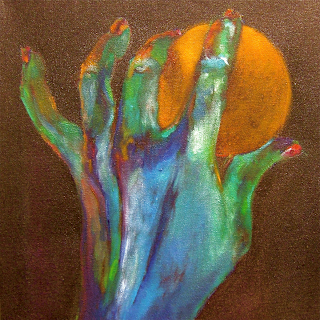From April 18 to May 1 I had a solo exhibition: Tableaux Transformations at the New Century Artists Gallery in Chelsea, NYC. The exhibit consisted of twelve oil paintings, one resin box with painted branches and leaves, and various objets d'art. Below are photographs of each of the four walls in the gallery with a listing of the paintings and objects depicted. All of the artwork will be available for viewing on my website: judyclifford.com by the beginning of May. If the artwork is featured in an earlier blog post it will be noted in parentheses next to the title.

Wall A
The artwork on this wall includes:
Calla Lilies: Dried flowers in resin displayed on a 42" pedestal fronted with fusion glass
Calla Lilies: Oil painting on panel, 37" x 23"
Dark Mannequin: Oil painting on panel, 37" x 23"
Dark Mannequin: Plaster sculpture with oil paint, necklace and fusion glass, displayed
on a 42" pedestal fronted with matching fusion glass

Wall B
The artwork on this wall includes:
Blue Perfume Collection: Oil painting on panel, 31" x 24"
Perfume Collection (Three Bottles): glass bottles with fusion glass and mosaic
displayed on small wooden table
Red Perfume Collection: Oil painting on panel, 24" x 18"
Nasturtium 1: Oil painting on panel, 19" square
Nasturtium 2: Oil painting on panel, 19" square ( Sept. 13, 2009)
Small Mosaic Table with Bouquet: Mosaic and resin on wood
with interior lined with fabric and oil painting under lid
Cat and Mouse: Oil painting on canvas, 37" x 23" (Oct. 3, 2009)

Wall C
The artwork on this wall includes:
Riad: Oil painting, 37" x 23" (April 25, 2010)
Slippers on a Line...: Oil painting on canvas with mosaic frame, 23.5" x 23.5"
Moroccan Slipper in Shadowbox: Slipper with fusion glass, 12" x 8"
Berber Doll in Shadowbox: Doll from Morocco, 8" x 6" (April 25, 2010)
Moroccan Pots: Oil painting on panel, 37" x 23"

Wall D
The artwork on this wall includes:
Branches Duo 1: Oil painting on panel, 37" x 23"
Branches in Resin Box: Natural branches and leaves
with oil paint and resin, 37" x 23"
Branches Duo 2: Oil painting on panel, 37" x 23"






























-cop.jpg)


